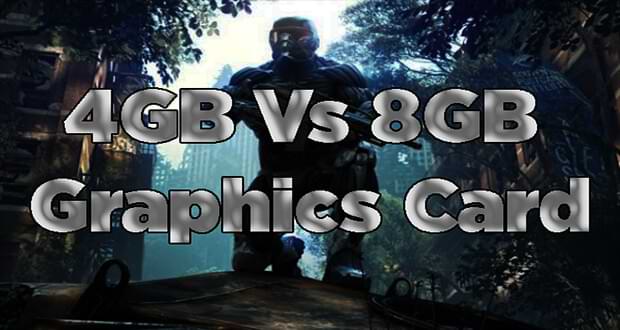Choosing between a 4GB and an 8GB graphics card is crucial for optimal gaming and graphics performance. As technology advances, the debate over these capacities’ suitability for various tasks intensifies. In this discussion, we’ll talk about the differences and their implications for gaming, content creation, and overall system performance. Let’s see the difference between 4GB vs 8GB Graphics Card.

Comparison Table About:
| Features – | 4GB Graphics Card | 8GB Graphics Card |
|---|---|---|
| Video Memory (VRAM) | 4GB | 8GB |
| Performance | Suitable for moderate gaming and general tasks | Better performance for high-end gaming and graphics-intensive applications |
| Resolution Support | Good for 1080p gaming | Better support for higher resolutions, including 1440p and 4K |
| Texture Detail | May require lower texture settings in some games | Better handling of high-resolution textures, improving visual quality |
| Future-Proofing | Limited future-proofing, may struggle with upcoming demanding games | Better future-proofing, more capable of handling future software requirements |
| Multi-Monitor Setup | Limited support for multi-monitor setups | Better suited for multi-monitor configurations, including gaming across multiple displays |
| VR (Virtual Reality) | Basic VR support may work for some VR applications | Improved VR performance, better for demanding VR experiences |
| Content Creation | Suitable for basic content creation tasks | More suitable for professional content creation, 3D modeling, and video editing |
| Cost | Generally more affordable | Typically more expensive |
| Energy Consumption | Lower power consumption | Higher power consumption may require a more robust power supply |
| Use Case Recommendation | Entry-level gaming, users | Enthusiast gaming, content creators, and professionals with demanding graphics needs |
Why Does Memory Capacity Matter?
Understanding the significance of memory capacity in a graphics card is essential for users seeking optimal performance and longevity. The memory, often referred to as VRAM (Video Random Access Memory), plays a pivotal role in storing and accessing the graphical data required for rendering images on your display.
1. Resolution and Texture Quality:
The primary impact of memory capacity is evident in the resolution and texture quality of the images displayed. Higher resolution and more intricate textures demand larger VRAM to store the additional graphical data. In this regard, 8GB cards hold a clear advantage over their 4GB counterparts, especially when dealing with modern games and resource-intensive applications.
2. Multitasking and Future-Proofing:
As software and games continue to advance, their system requirements grow as well. Opting for an 8GB graphics card provides a level of future-proofing, ensuring that your system can handle upcoming releases and updates without compromising performance. If you engage in multitasking, such as streaming while gaming or running resource-heavy applications concurrently, the extra VRAM becomes indispensable.
How to Do 4GB Vs 8GB Graphics Card Differ?
Now that we understand the importance of memory capacity let’s delve into the specific differences between 4GB and 8GB graphics cards.
1. Memory Bandwidth:
Memory bandwidth is another factor that determines how quickly the GPU can access & utilize the VRAM. While both 4GB vs 8GB cards may share similar memory bandwidth, the larger capacity of an 8GB card allows for more efficient utilization of this bandwidth. That results in smoother performance, especially in scenarios with high-resolution textures and complex graphical data.
2. Performance in Demanding Games:
In the gaming landscape, where the demand for graphical prowess is ever-increasing, 8GB graphics cards demonstrate their superiority. AAA titles with high-quality textures and intricate details often require more than 4GB of VRAM for optimal performance. The additional memory of an 8GB card provides a comfortable buffer, preventing bottlenecks and ensuring a seamless gaming experience.
3. Content Creation and Productivity:
Beyond gaming, content creators and professionals working with graphic-intensive applications also benefit from the enhanced capabilities of 8GB graphics cards. Video editing, 3D rendering, and graphic design tools leverage the extra VRAM, allowing for smoother workflow and quicker rendering times.
When to Choose 4GB Vs 8GB Graphics Card?
Determining whether a 4GB or 8GB graphics card is the right choice for you depends on your specific needs and usage scenarios.
1. Gaming and Basic Tasks:
If your usage is primarily focused on gaming, web browsing, and basic tasks, a 4GB graphics card may suffice. Many older or less demanding games can run smoothly within this memory capacity, providing a cost-effective solution for users on a budget.
2. Mid-Range Gaming and Productivity:
For users who engage in mid-range gaming & productivity tasks, such as photo editing or light video editing. An 8GB graphics card strikes a balance between performance & cost. It ensures a smooth experience in a broader range of applications without breaking the bank.
3. Enthusiast Gaming and Content Creation:
Enthusiast gamers and content creators working with resource-intensive applications should opt for an 8GB graphics card without hesitation. The enhanced memory capacity not only meets the demands of current software but also provides a level of future-proofing for upcoming releases.
Conclusion:
In the dynamic world of graphics cards, the choice between a 4GB and 8GB model holds profound implications for your overall computing experience. While 4GB cards may cater to budget-conscious users with modest requirements, the 8GB counterparts undoubtedly offer a more robust and versatile solution, excelling in demanding tasks and ensuring longevity in the face of evolving software demands.
The decision between a 4GB and 8GB graphics card depends on individual needs and usage. While 4GB suffices for gaming, the 8GB option offers superior performance in graphics-intensive tasks. Consider factors like budget and future-proofing when making a choice, as technology evolves, demanding higher VRAM capacities for an optimal user experience.
